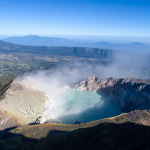
Even though some populations may not be at their target level, U.S. wild-caught greater Amberjack is still a good seafood option because it is responsibly harvested and sustainably managed under U.S. regulations.
Biology
- Greater amberjacks can grow to six feet in length and can live up to 17 years.
- Adults can weigh as much as 200 pounds but most adults are between 40 and 50 pounds.
- Females live longer and grow in size than males.
- Greater amberjack mature between 3 and 4 years old and spawn mostly on shipwrecks and reefs from March through June. One spawning season can see a female release anywhere from 18 to 59 million eggs.
- Adults mostly eat crab, squid and other fishes that are found on coral reefs.
- Juveniles eat plankton, which includes crustacean larvae, and small invertebrates.
- The Atlantic and Pacific Oceans are home to greater amberjack.
They can be found in the western Atlantic from Nova Scotia to Brazil, which includes the Gulf of Mexico, and the Caribbean.
Habitat
The juvenile greater amberjacks are taught to swim around the mats of open ocean Sargassum in Mexico. Sargassum, an alga that provides food and protection to juvenile fish and other invertebrates in open ocean waters, is called Sargassum. Schooling behavior decreases as greater amberjack matures.
At 5-6 months old, they shift from pelagic to demersal (nearer the ocean bottom) habitats. Adults and sub-adults congregate around reefs and rocky outcrops.
While some populations may live in one location, others might migrate to other areas.
The article was written by a professional charter captain at Salty Knots Fishing Charters with 15+ years of experience in the Gulf of Mexico. Salty Knots Fishing Charters is a local fishing charter service based out of St. Pete Beach, Florida. “We know what it takes to catch a giant trophy fish!” Salty Knots Is the best when it comes to St. Petersburg deep sea fishing.




